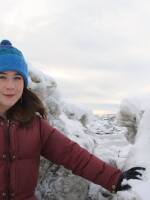For her doctoral dissertation, Yoko Kugo is visiting old village sites, speaking with elders and taking pictures to document the traditional names of places around the lake.
A creek runs into the river at the base of a bluff along the Kvichak. At the top of the hill, grass covered pits mark the foundations of old buildings, evidence of an abandoned settlement. It likely has a Yup’ik name. Yoko Kugo, a doctoral candidate in anthropology at the University of Alaska Fairbanks, is hoping to find out from elders in the nearby village of Igiugig what it is.
Kugo is in the midst of research for her dissertation, a three-year project to document the Yup’ik names of places around Iliamna Lake. As she conducts field work at the old settlement, she photographs the creek, house pits, an old cross that would have marked a grave, and a metal bell that lies in the dirt. She will take these photos back to the village. From there, she will interview elders about the area’s history and about what the creek, site, and artifacts are called in their native language.
“I ask them about the place names, also how they used to get there, what time of the year they went there. So it’s not just the place name. But it’s the story behind the places,” she explains.
In Igiugig, Kugo’s work dovetails with the work of the Village Council President, AlexAnna Salmon. Salmon has dedicated years to recording the history and Yup’ik names of places around the village where she grew up.
“So it’s just learning about how the Yup’ik chose to orient themselves and what they chose to name and why. So there’s a lot of cultural, ecological knowledge that are in those place names as well as, for some people, family history that would be lost without having recorded that,” says Salmon.
To underline the importance of native place names, Salmon points out that they can be key to understanding how the area has changed over time.
“A lot of times the place names were places where they harvested certain resources, like Naruyatuli, an island that was known for all of its seagull eggs. If you went back there today and saw that there were no seagulls that would tell you another story. Thousands of years ago there must have been a lot of seagulls here, but today there aren’t any. So what’s happened?”
Kugo’s research will broaden the context for the work already done in Igiugig. Salmon is excited that Kugo is bringing that energy to other villages around Iliamna Lake.
“Yoko is just expanding what we’ve done to the whole region, which is extremely wonderful because Kokhanok, and Levelock, and Iliamna and Newhalen, they’re our cousin villages,” Salmon says. “So now we’ll have the whole picture rather than just our piece from our elders.”
Since Kugo began the project last summer, she has visited Newhalen, Iliamna, Kokhanok, and Igiugig. In those villages, she has interviewed more than a dozen people. Kugo has funding from the National Science Foundation to continue for two more years. When she is finished she plans to create a physical map and an online database of place names and their histories for the communities that she studies.
Contact the author at avery@kdlg.org or 907-842-5281.




